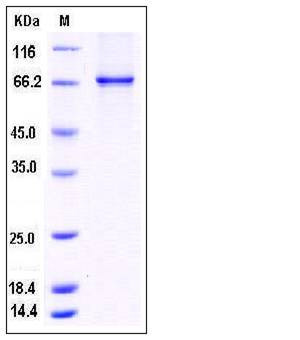Human CSNK1G1 / CKI-gamma 1 Protein (His & GST Tag)
CK1gamma1
- 100ug (NPP3777) Please inquiry
| Catalog Number | P11569-H20B |
|---|---|
| Organism Species | Human |
| Host | Baculovirus-Insect Cells |
| Synonyms | CK1gamma1 |
| Molecular Weight | The recombinant human CSNK1G1/GST chimera consists of 659 amino acids and has a calculated molecular mass of 76.3 kDa. It migrates as an approximately 66 kDa band in SDS-PAGE under reducing conditions. |
| predicted N | Met |
| SDS-PAGE |  |
| Purity | > 94 % as determined by SDS-PAGE |
| Protein Construction | A DNA sequence encoding full length of human CSNK1G1 (NP_071331.2) (Met 1-Lys 422) was fused with the N-terminal polyhistidine-tagged GST tag at the N-terminus. |
| Bio-activity | The specific activity was determined to be 4 nmol/min/mg using casein as substrate. |
| Research Area | Developmental Biology |Embryogenesis |Axis Formation |Canonical Wnt Pathway |
| Formulation | Supplied as sterile 20mM Tris, 500mM NaCl, 10% gly, pH 7.4 1. Normally 5 % - 8 % trehalose, mannitol and 0.01% Tween80 are added as protectants before lyophilization. Specific concentrations are included in the hardcopy of COA. |
| Background | Casein kinase I isoform gamma-1, also known as CSNK1G1, is a member of the protein kinase superfamily, CK1 Ser/Thr protein kinase family and casein kinase I subfamily. The casein kinase I family of protein kinases are serine / threonine-selective enzymes that function as regulators of signal transduction pathways in most eukaryotic cell types. Casein has been used as a substrate since the earliest days of research on protein phosphorylation. Casein kinase activity associated with the endoplasmic reticulum of mammary glands was first characterized in 1974 and its activity was shown to not depend on cyclic AMP. The CKI family of monomeric serine–threonine protein kinases is found in eukaryotic organisms from yeast to human. Mammals have seven family members: alpha, beta 1, gamma 1, gamma 2, gamma 3, delta, and epsilon. The family members have the highest homology in their kinase domains (53%–98% identical) and differ from most other protein kinases by the presence of the sequence S-I-N instead of A-P-E in kinase domain VIII. The CKI family members appear to have similar substrate specificity and substrate selection is thought to be regulated via subcellular localization and docking sites in specific substrates. |
| Reference |
